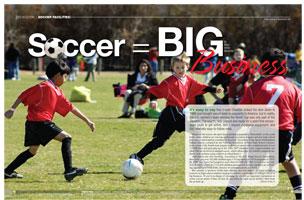
It's easy to say that Brandi Chastain kicked the door down in 1999 and brought soccer back to popularity in America, but in reality, the U.S. women's team winning the World Cup was only part of the equation. The country was primed and ready for a sport that encouraged youth to get active, didn't require expensive equipment, and had relatively easy-to-follow rules.
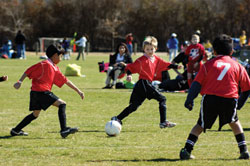 Whatever the reason, the sport has exploded in popularity. Particularly on the youth level, where children are moving up through recreation leagues and into high school play, soccer participation continues to increase. According to the Sports Participation Figures Survey compiled by the National Federation of State High School Associations, soccer is the fourth most popular high school sport, with a combined total of over 715,000 boys and girls playing in the 2006-2007 academic year. (Approximately another 500 are involved in adapted soccer, which allows play by mobility-impaired students, such as those using walkers or wheelchairs.)
Whatever the reason, the sport has exploded in popularity. Particularly on the youth level, where children are moving up through recreation leagues and into high school play, soccer participation continues to increase. According to the Sports Participation Figures Survey compiled by the National Federation of State High School Associations, soccer is the fourth most popular high school sport, with a combined total of over 715,000 boys and girls playing in the 2006-2007 academic year. (Approximately another 500 are involved in adapted soccer, which allows play by mobility-impaired students, such as those using walkers or wheelchairs.)
And players are still enrolling. According to the U.S. Youth Soccer Association, there were just over 103,000 children ages 5-19 registered in USYS programs in 1974. By 1980, that figure had jumped to more than 810,000. By 1985, it went over one million. In 2007, a total of 3,123,698 children participated, and the numbers are still rising, according to Todd Roby, director of communications at USYS.
But whether it involves world class athletes, pee-wee players on local recreation councils or high school students hoping for athletic scholarships to college, soccer is big business. If you're in charge of choosing the site for an important tournament or event, you are aware of that. So how do you select the right soccer facility? Start from the ground up.
Your Chosen Field
Soccer is played on a field, known as a pitch, the size of which depends upon the age and skill level of the participants. Different governing bodies (the organizations setting forth the rules and regulations for that particular level of the sport) have varying requirements. The standards of international soccer governing body FIFA, (or Fédération Internationale de Football Association, which is French for International Federation of Association Football) differ from the standards for collegiate, high school or youth play. (A list of governing bodies is adjacent to this article).
Even within the standards of a governing body, field sizes can vary. For example, a high school field may be 55 yards to 80 yards wide, and 100 yards to 120 yards long. The National Collegiate Athletic Association, or NCAA, states that for college fields, "the width shall not be more than 80 yards (73.15 meters) nor less than 65 yards (59.44 meters) and the length shall not be more than 120 yards (109.73 meters) nor less than 110 yards (100.58 meters); however, fields of less than minimal dimensions may be used by prior written mutual consent of the competing institutions. The optimum size is 75 yards (68.58 meters) by 120 yards (109.73 meters). New facilities shall be a minimum of 70 yards (64.01 meters) in width by 115 yards (105.15 meters) in length."
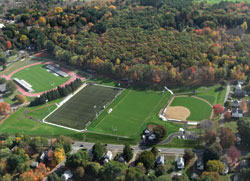 FIFA's rules, meanwhile, state that fields must be a minimum length of 90 meters (100 yards) and a maximum of 120 meters (130 yards). The width must be a minimum of 45 meters (50 yards) and a maximum of 90 meters (100 yards). For international matches, FIFA specifies a length of minimum 100 meters (110 yards) and maximum 110 meters (120 yards), with a width of minimum 64 meters (70 yards) and maximum 75 meters (80 yards).
FIFA's rules, meanwhile, state that fields must be a minimum length of 90 meters (100 yards) and a maximum of 120 meters (130 yards). The width must be a minimum of 45 meters (50 yards) and a maximum of 90 meters (100 yards). For international matches, FIFA specifies a length of minimum 100 meters (110 yards) and maximum 110 meters (120 yards), with a width of minimum 64 meters (70 yards) and maximum 75 meters (80 yards).
Youth soccer follows the guidelines of standard field sizes; however, the U.S. Youth Soccer recommends that younger children play Small-Sided Soccer, which is essentially soccer on smaller fields with fewer players, which enhances individual skill development. (USYS supplies recommendations for field sizes and numbers of players based upon specific age groupings, beginning with those under six and going up to those under 12.) The fields for the U.S. Youth Soccer National Championships for older children are 70 yards wide by 110 yards long for players under age 14, and 75 yards wide by 110 yards long for ages 15-19.
Most governing bodies also set rules governing width and placement of lines, and size and placement of the goal itself. If your event will include night play, make sure the lighting meets the standard of the appropriate governing body.
Note: While field dimensions were taken from the most current websites of each organization, the rules for sports are constantly changing and the different governing bodies publish their changes at different times of the year. Always obtain the most current rules and make sure your chosen facility is in compliance.
On the Surface
A soccer field may be made of natural grass or synthetic turf. Both are acceptable for play, and both have their advocates and their detractors.
Those who prefer fields of natural grass, like Robert J. Cohen of Sport Surfaces Distributing, Inc. in Albuquerque, New Mexico, claim that a soccer ball bounces too much on an artificial turf surface. An example of the difference, he adds, is similar to first bouncing the ball on a grass field (where the bounce essentially dies), and bouncing it on a sidewalk. "Soccer balls tend to bounce and bounce, right off the pitch," he notes, "rather than stopping as they would on grass. This is not a significant factor in football, but is a huge issue for soccer."
Some builders, like John Schedler of FieldTurf Tarkett in Highlands Ranch, Colorado, say that many modern artificial turf systems play much more like natural grass. They refer to the FIFA website (address below) which contains news and information on studies performed on various playing surfaces for soccer.
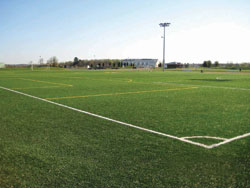 Graham Hayes works with DOC Sports Surface Contractors LLC in Fort Washington, Maryland. The company recently built three artificial turf fields that are part of the Maryland Soccer Complex in Boyds, Maryland, which offers a total of 24 fields, as well as a range of other recreational facilities. Hayes believes an artificial turf facility can be successfully used in soccer installations when constructed properly.
Graham Hayes works with DOC Sports Surface Contractors LLC in Fort Washington, Maryland. The company recently built three artificial turf fields that are part of the Maryland Soccer Complex in Boyds, Maryland, which offers a total of 24 fields, as well as a range of other recreational facilities. Hayes believes an artificial turf facility can be successfully used in soccer installations when constructed properly.
"I think knowing what the drainage system is for an artificial turf field is important because rain can greatly impact the playing surface for soccer," he notes. The Maryland Soccer Complex, he adds proudly, "has never had to close the fields due to standing water. So far, no rain event has been so heavy that it has prevented play on the surface, because the drainage system's capacity is so high. The complex has had teams cancel because of weather but it has never lost revenue due to field conditions."
The American Sports Builders Association (ASBA), the national organization for designers, builders and suppliers of materials for athletic facilities, has no official statement comparing the surfaces, and advises event planners of sports events to consult the managers of the facilities themselves, the governing body of the sport being played, or the manufacturers of the specific surface used, to make an informed decision.
Whichever surface is chosen, it must be kept in shape. Grass requires weeding, watering, fertilization and mowing. Its fields cannot be played on constantly without a ‘rest period' which allows the grass to recover from the impact of many players running across it, kicking at it and so on. Artificial turf, though it does not need to rest, should be cleaned, groomed and sanitized regularly. Both fields will need to have adequate water drainage to ensure playability.
"Make sure the line striping is clear for soccer if the field is used for multiple sports," says Don Smith, of Don Smith, CTB, LLC in Lakewood, Colorado. "This is especially important on synthetic turf where lines are often inlaid for multiple sports, including football, soccer, rugby and lacrosse."
The Setting
If you've settled on a surface, it's time to weigh other aspects of the facility. Devin Conway of Verde Design in Santa Clara, California can check off a list.
"From what my clients tell me, and they are really the true authority here, the soccer fields' playing surface is important in terms of dimensions - and this varies greatly dependent on the age group and level of play or competition - and overall quality, notably the field grading, drainage quality and turf condition, but they're not the more important considerations. Obviously it depends on what type of event or tournament is being considered, but there are the key considerations to the event being held at your facility."
According to Conway, certain things differentiate a regular field from an outstanding facility:
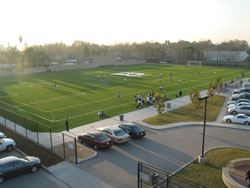 Parking: Whether your players arrive in a team bus and trailed by fans, or whether they roll up in minivans driven by devoted parents, parking is essential. Spectators, officials, team personnel, (and depending upon the level of play, scouts appearing on behalf of schools or teams) will all want to be close to the facility.
Parking: Whether your players arrive in a team bus and trailed by fans, or whether they roll up in minivans driven by devoted parents, parking is essential. Spectators, officials, team personnel, (and depending upon the level of play, scouts appearing on behalf of schools or teams) will all want to be close to the facility.
Seating: There should be separate seating for players (and team personnel), spectators, media and officials. Sure, parents and fans of really young children are used to showing up with folding chairs, but for a special event where larger crowds are expected, designated seating is essential. Temporary or portable bleachers can be used if space permits. ADA considerations apply.
Conveniences: On-site rest rooms (or portable toilets and hand sanitizing stations) are necessary. Refreshment stands are important too. Booths for souvenir sales will allow teams to fund raise.
Amenities: Public areas should be well-lit. A public address system is necessary, as is a score board with a clock.
Emergency Facilities: If the venue does not have a first-aid tent or office, it must be accessible to emergency personnel.
Media-Friendly: Want newspaper, radio and/or TV coverage?Look for a facility that has a working press box with all the extras - electricity, phones and wi-fi.
Define your needs: If multiple teams will be playing simultaneously, you'll need multiple fields. As mentioned previously, facilities with lighting can extend the playing day and accommodate more games, or events that go into overtime.
Tailgating: Will your event draw the tailgate crowd? If so, you'll want a place with bathroom facilities nearby. Secure all permits in advance.
Weather: If an important competition is scheduled and the weather is iffy, have an emergency back-up site, such as an indoor soccer or multi-sport arena. Check with local colleges, soccer clubs and others for information. Depending upon the playing surface, some facilities may require players to wear flat-bottomed shoes.
Things to Remember
Sports competitions require extensive planning. Don't overlook the basics:
Get it in writing: Find out about permitting, insurance and more. Will transportation be necessary to take players to and from playing sites? Will special arrangements need to be made for parking? Should anything be cleared with the local athletic association, or the state branch of the national governing body?
Officials: Game officials should know the rules for the sport with regard to the governing body and age group being hosted. The local high school or collegiate athletic association, recreation council, etc. can help point you in the right direction. For an event being held during a busy sports season, officials' time should be reserved in advance.
Accommodations: Are there hotels, motels and campgrounds available? Even the best-run soccer event will be complained about if accommodations aren't convenient to the competition site.
What's Fun? All sporting events should be accessible to attractions that players, spectators and others can take advantage of during downtime. Of interest to youth might be areas with restaurants, malls and recreation like mini-golf, theme parks or water parks. Older players might prefer historical sites, cultural attractions or nightlife.
Soccer is an enjoyable sport, but it's challenging too. Finding the perfect facility to host the sport can be challenging also. The good news? You can score - just focus on the goal.
Websites of various governing bodies and informational organizations:
FIFA (Fédération Internationale de Football Association (English translation: the International Federation of Association Football), the international governing body for soccer): www.fifa.com.
United States Soccer Federation (Governing body for soccer in the United States, encourages play on the recreational and competitive levels): www.ussoccer.com.
National Collegiate Athletic Association (Governing body for collegiate sports): www.ncaa.org.
National Federation of State High School Associations (National service and administrative organization of high school athletics and fine arts programs): www.nfhs.org.
U.S. Adult Soccer Association (Encourages adult play among those who have advanced beyond the age of youth or scholastic soccer): www.usasa.com.
U.S. Youth Soccer Association (Sports organization for youth soccer programs): www.usyouthsoccer.org.
U.S. Paralympics (A division of the U.S. Olympic Committee, dedicated to providing opportunities to physically challenged athletes): www.usparalympics.org.
National Soccer Coaches Association of America (organization sharing information on coaching, rules and more): www.nscaa.com.
National Intercollegiate Soccer Officials Association (organization dedicated to improving the quality of soccer officiating, which also compiles information on the comparative rules according to FIFA, USSF, NCAA and NFHS): www.nisoa.com.
Note: Rules in sports may change from year to year; ensure the most updated rules are available.
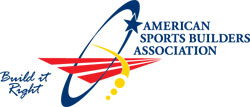 Note: The American Sports Builders Association (ASBA) is a non-profit association of designers, builders and suppliers of materials for athletic facilities. The ASBA offers meetings and publications on sports fields, running tracks, tennis courts and indoor sports facilities. Available at no charge is a listing of all publications offered by the Association, as well as the ASBA's Membership Directory. Please visit www.sportsbuilders.org.
Note: The American Sports Builders Association (ASBA) is a non-profit association of designers, builders and suppliers of materials for athletic facilities. The ASBA offers meetings and publications on sports fields, running tracks, tennis courts and indoor sports facilities. Available at no charge is a listing of all publications offered by the Association, as well as the ASBA's Membership Directory. Please visit www.sportsbuilders.org.

